An executive notices a Kanban board in a highly visible location and expresses concerns to the project manager that too many people will see it. What should the project manager do?
A team working with a new technology faces a significant amount of uncertainty about its ability to deliver stories due to technical issues. What should the team do?
During a coaching session, an agile project manager discussed embracing communication to keep all stakeholders aligned. The agile project manager recently had a discussion with their team and decided to display a product roadmap.
What is the agile project manager trying to show?
An organization strives hard to accelerate value delivery by improving product design, development, and transition activities. What ways of working should the organization discontinue to become an effective player?
What should the Scrum Master do next?
During the iteration planning of a newly onboarded agile team, the product owner adds a set of high priority user stories into the iteration backlog. What should the team do first to define the tasks needed to implement the user stories?
DRAG DROP
All the developers on a project team are working offshore in a different time zone, resulting in many issues. Match the issues to the agile practitioner's recommendations for resolutions below. (Drag the Problems/Issues on the left to the box in the center, corresponding to the correct Recommendations for Resolution on the right)
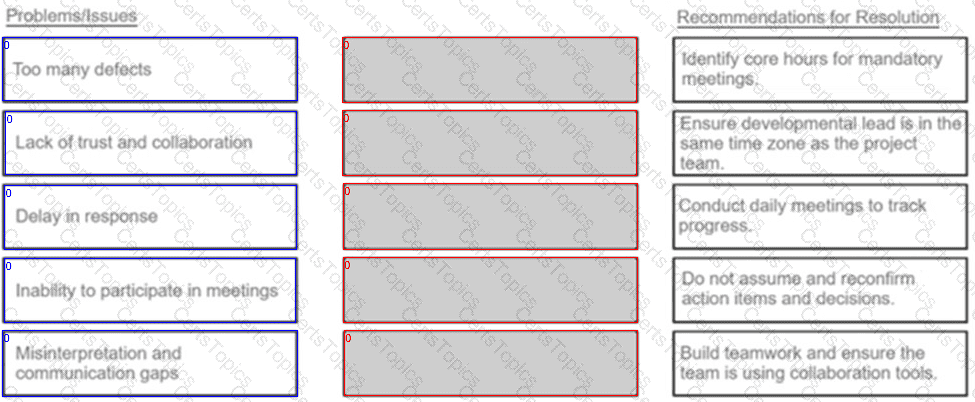
During planning for the next iteration, an agile team identifies most of the story points that are expected to be delivered. How should an agile practitioner work with the team to help identify the iteration's remaining scope?
In several recent agile team status meetings, there have been discussions about increases in costly bugs and late product deliveries, resulting in lower quality and higher costs. Team members feel they spend too much time in planning and process meetings, then feel rushed to complete their work.
How should the agile lead implement an effective and efficient solution?
What should the agile project manager do?
During planning, a project team and sponsor created a visual representation of the high-level specifications of the features and user stories to be implemented in a product. Consensus was achieved on this high-level depiction of the product characteristics, but the sponsor is having difficulty understanding what to develop and when.
How should the project manager explain this to the customer and save time in the meeting?
A project was delivered in a foreign country for a big customer, but there are a lot of complaints about the way the functionality was implemented. Now there is a new project to fix the defects of the first one.
What strategy should be used to deliver it successfully?
What should the agile project leader do?
What should a product owner do when a new stakeholder is complaining that they are not receiving the relevant financial data regarding the project.
A healthcare agency has contracted a vendor to provide a financial accountability solution. During a daily coordination meeting, the lead developer reports they cannot complete the stories for this iteration because the project director requested a document detailing all testing planned for the solution. The team lead met with the project director to discuss alternatives but insists they need the detailed plan by the end of that week. The team lead advises the lead developer to continue coding.
What should the team lead do next?
A globally distributed project team is using email and phone calls as the only way to share information. Delays in resolving issues often occur due to misinterpreted communications, leading to a lower team velocity.
What steps should the project leader take to improve knowledge sharing?
A newly formed Scrum team wants to foster an environment of transparency and experimentation. The team decides to use a Kanban board to record and track encountered impediments. Emphasis is placed on how issues are resolved and the strategies for preventing them in the future. Over time, what will be the result of this approach?
A team's technical lead believes that manual testing tasks should be conducted by junior team members below their level. The junior team members think it is unfair and refuse the tasks.
What should the Scrum Master do?
A scrum master is part of a team that has just agreed on the project scope and deliverables for a global, multilingual manufacturing company that has many staff members moving between locations. The team consists of 20 people and the budget is US$5 million. The kickoff meeting is scheduled for the following month.
What should the scrum master do as a first step?
The product owner working on an agile software development project has brought all the Scrum team members together for the first sprint planning meeting. The team has read the user stories and has provided estimates to complete these user stories. The product owner plans to empower the team to get the work done.
What is this an example of?
A development team is working on the implementation of a human resources (HR) solution. The team has decided to work together with different business units to deliver value early and often.
Which agile values are being practiced in this scenario?
A newly formed team is struggling to work together and agree on how to complete tasks in the upcoming sprint. What should the scrum master do to support the team?
What should the agile coach do?
During a project review, the team discovers customer feedback that would add scope. The project leader is concerned that the team will be unable to incorporate this feedback and still meet the product launch date.
What should the project leader do?
Toward the end of a project, the product owner discovers that the project has a high probability of failure due to a critical feature not functioning as expected.
What should the product owner do?
The agile lead is told by executive leadership that the team needs to work faster because the release date has been moved up three months. The agile lead communicates the updated timeline to the team. One of the junior team members objects and feels the timeline is unrealistic.
What should the junior team member do?
What should the agile practitioner do?
A team worked with a customer to estimate all user stories for the must have features. During release planning sessions, the customer indicated they prefer 3-week iterations that begin on Thursdays and end on Wednesdays. The team spent several days determining which stories should be developed for iteration 0 and understanding the customer’s priorities for the remaining stories. The project sponsor attends the Friday meeting and requests a high-level estimate of when they can invite the chief executive officer (CEO) to a demonstration of the minimum viable product (MVP).
What should the team tell the sponsor at this point in the planning process?
A project team held a working session with a finance team to understand the procurement process. After the meeting, while the agile lead was facilitating the value stream mapping exercise, one of the team members asked: "When calculating the cycle time, which factors should be considered?"
How should the agile lead respond?
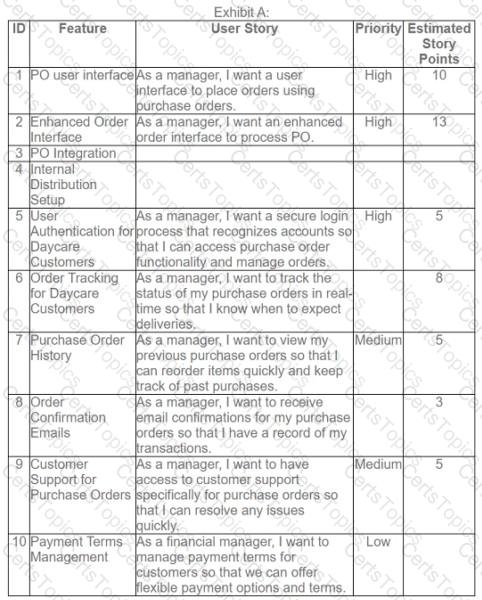
A food company seeks additional business-to-business (B2B) revenues from some customers by
implementing purchase order (PO) functionality. To achieve this, the agile project team is exploring PO integration options (see item #3 in Exhibit A), as the product increment (PI) planning process is underway.
What should the project team do next?
An agile team consisting of eight members is in their 11th iteration of a project. In the last iteration, the team was not able to complete every scope item it had committed to before the demonstration.
Which approach should the agile lead take?
An agile team consisting of eight members is in their 11th iteration of a project. In the last iteration, the team was not able to complete every scope item it had committed to before the demonstration.
Which approach should the agile lead take?
What should the Scrum Master do?
How can an agile practitioner ensure that all key stakeholders are properly engaged in planning?
A team retrospective was going well until the team lead introduced the "define the next experiment" topic; then the discussion became an argument. A new team member feels strongly that the approach used on their previous team would improve this team's efficiency and effectiveness. The team lead is adamant that they remain with the current approach and the discussion dissolves into a circular argument.
During its first sprint, a new Scrum team realizes that it has insufficient team members with test automation skills to effectively complete its stories.
What should the team do?
What should the Scrum Master mention at the next retrospective?
A project manager is managing a large complex project with cross-functional teams using an adaptive approach. Frequent communication among the team leads of these cross-functional teams is crucial for the project to stay on track and deliver value according to the project plan.
Which agile communication practice should the project manager implement to ensure the cross-functional teams interact frequently?
An agile lead is working with a team to deliver a new product. During a sprint, a junior team member has been taking too long to deliver a story. During daily coordination meetings, the junior team member does not mention any impediments they might be facing. Senior team members realize the delay but remain quiet. During a one-to-one conversation, the agile lead discovers the junior team member is struggling with a technical issue but feels too intimidated to ask for help.
What should the agile lead do?
An agile lead is working with a team to deliver a new product. During a sprint, a junior team member has been taking too long to deliver a story. During daily coordination meetings, the junior team member does not mention any impediments they might be facing. Senior team members realize the delay but remain quiet. During a one-to-one conversation, the agile lead discovers the junior team member is struggling with a technical issue but feels too intimidated to ask for help.
What should the agile lead do?
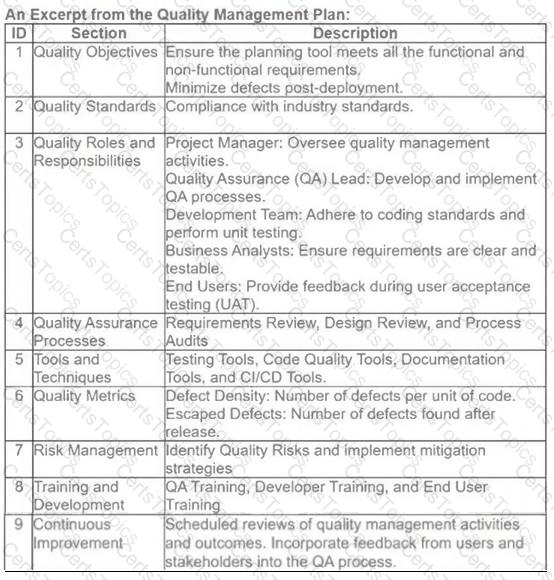
In a project to develop a supply-and-demand scenario planning tool, the team aims to streamline development and rapidly deliver features. Which approach best supports quick feature delivery while maintaining quality? (Refer to An Excerpt from the Quality Management Plan)
What should a Scrum Master do when an agile team member is behind on their tasks?
The coach on a new agile team notices that one team member is influencing most of the team's decisions. What should the coach do?
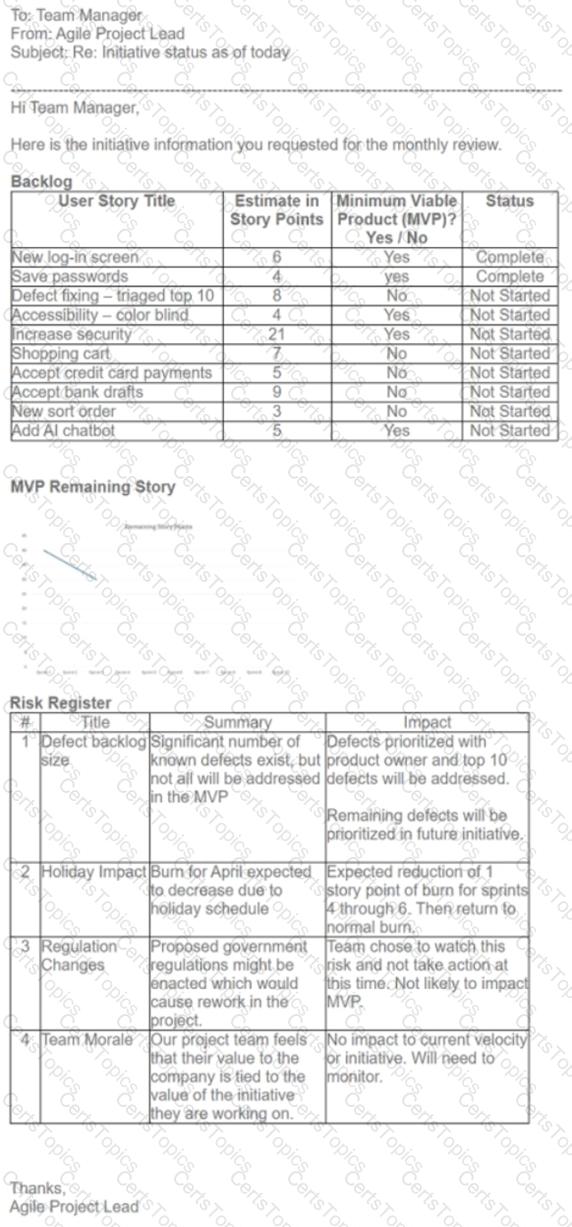
A project team's manager is responsible for delivering a specific initiative for the organization. They are preparing for a monthly meeting where the manager will present on the current state of this initiative. The agile project lead sends the manager the following email with the current initiative status (see Exhibit A).
How many sprints will be needed to complete the entire backlog?
How could the project leader have avoided this?
An agile team has been given a complex project with a basic set of requirements which need further elaboration and review. How should the team iteratively build out the backlog of requirements with the stakeholders?
During the high-level estimation for a project, the team contacted the product owner about the client’s requirements. The team is seeking guidance as their estimate is too big and there is a risk of not finishing the project in time.
What should the product owner do to help the team?
An agile lead is experienced with predictive and agile approaches. The agile lead was recently invited by human resources (HR) to be part of a learning team. During roundtable discussions with the project management team, the agile lead states: "I foster a safe environment for disagreement so my team feels empowered to move forward without obstacles."
What is the agile lead attempting to highlight?
A Scrum team has worked hard to reach their sprint goal, but impediments have prevented them from succeeding. The team needed help from a specialist on another team, but the specialist was on a 2-week vacation.
What should the scrum master do?
What should the agile practitioner do?
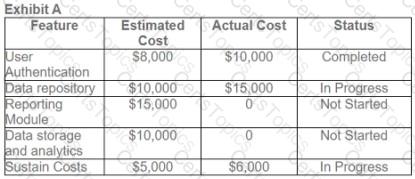
The product owner is working on an application that will be built in a data lake leveraging a data
integration and transformation software application. With a budget of US$17,000 remaining, how should the product owner allocate the money? (Refer to Exhibit A)
An agile practitioner is working on a project to migrate data from computer systems to another location. To accomplish this task, they need to run four activities sequentially that different teams are performing. The teams are migrating two systems per day, but the agile practitioner thinks that three systems should be done per day.
What can be done to improve process efficiency?
A scrum team is working on an important project with a short deadline. To save time and reduce overhead, the product owner proposes that the regular sprint reviews should be cancelled and replaced with a review of each release according to the release plan.
What should the scrum master do?
What should the agile coach do in this situation?
An agile project manager is leading an international project involving a global team consisting of members from very different cultures, countries, and time zones. The agile project manager is aware that similar projects with distributed teams have led to serious conflicts.
What should the agile project manager do to promote trust and collaboration?
The Agile team has failed to meet their iteration goal, and contention has developed between members. The Agile Leader would like to determine how to improve the team’s productivity and morale.
How should the Agile Leader address this?
How can the scrum master respond to a stakeholder who suggests using velocity as a metric to measure team efficiency in an agile project?
Following a successful product release, senior management asks an agile team how to improve the value of the product for the next release.
What should the team do?
There is a throughput of 200 tickets in a customer service line. The tickets are raised by employees, with each 8-hour shift averaging 50 tickets in progress.
What is the cycle time to resolve a ticket?
What should the agile practitioner have done to ensure stakeholder satisfaction?
What action should the product owner take?
What should the customer do?
One of the overseas stakeholders on an agile project has not been actively involved in the project's development. What would be the first step to reengage the stakeholder?
What is a specific development practice that has been effective in implementing disciplined DevOps?
A product roadmap should contain which of these primary components?
What should the agile coach do to develop members into a high-performance team?
An Agile team has received several new features to be added to the product backlog. The team is struggling to provide a reasonable estimate for feature development due to a lack of experience.
How should an experienced Agile practitioner assist the team?
A project team is currently working on sprint seven of a release that is estimated to require twelve sprints to complete. The team has reviewed the stories for this sprint and discovered that it will require rework from previous sprints.
What should the Scrum Master do?
A company has decided to use an agile delivery method for launching a new product to improve the customer checkout experience. How should the project manager ensure the experienced predictive delivery teams are capable of adopting the agile model?
How can a project team effectively work toward a common goal and communicate as they scale and expand to build a new business-critical platform, given that they have been responsible for a small customer-facing product with little complexity over the past 2 years?
Unable to meet a sprint's committed velocity, an agile team approaches the agile coach to define the next sprint's velocity. What should the agile coach advise?
An agile coach is working with a team that serves clients making product requests by phone. During a daily commitment and replanning meeting, a team member states that they were unable to resolve a client request because they lacked sufficient product knowledge.
What should the agile coach do?
Roadmaps are defined as covering a rolling 12 months. When creating a product roadmap in an agile environment, what factor should the agile lead take into consideration?
A new project is scheduled to begin next month. The project manager has had plenty of time to review and plan all the activities and has adopted the best approach for the project and the organization.
Which action did the project manager most likely take when choosing the approach?
During a recent sprint review meeting with stakeholders, the product owner received detailed feedback indicating the critical changes needed for upgrading the legacy system to better align with the latest technologies and user needs. How should the product owner help ensure the product backlog is effectively managed, while helping the team remain focused? (Refer to the Product Backlog Exhibit)
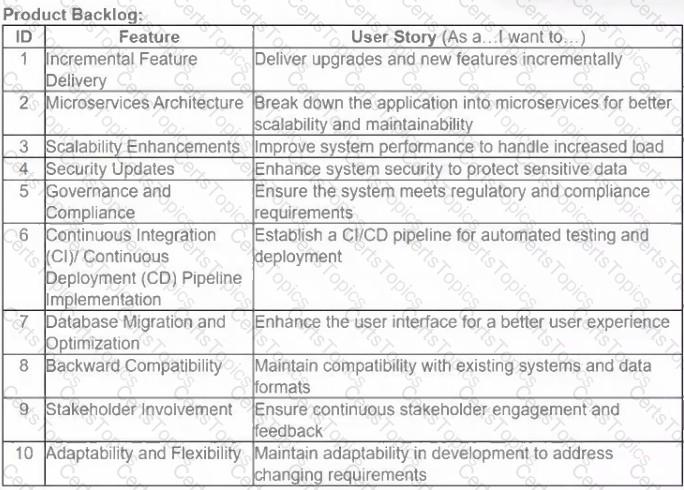
What should the team have done to prevent this?
A new team member asks what changes could accelerate a change to the project plan.
What should be the proper response?
During a retrospective, a team member claims that a specific set of documentation that is continuously updated during iterations is not being used by any stakeholder.
What should the team do?
An agile project manager has noticed their teams declining morale, mistrust, and isolation over the last 6 months of working on a project. What should the agile project manager do to enhance productivity and create a cohesive team culture?
A project is to be started with a team of nine existing and nine new members. The Scrum Master feels that the team is too large and wants to break it into three teams. The Scrum Master sets a constraint that each team have an equal number of existing team members for knowledge sharing and experience.
What should the Scrum Master do to accomplish this?
What should the agile practitioner do?
On an agile project, it is important to identify and engage business stakeholders throughout the project and to ensure the team understands the stakeholders' business needs. Which option supports this idea?
An agile team is in their 2nd iteration planning session. During the session, they are debating on whether regression and integration testing should be part of every iteration or part of the hardening iteration.
What should the agile lead recommend?
A team is preparing to demonstrate new product capabilities to a leadership team. The demonstration will show working software and a listing of the projected value of the capabilities.
What should the team do to ensure the demonstration is successful?
In an adaptive environment, project managers use their skills and expertise to help the team adapt to changing circumstances and deliver to their stakeholders. While some agile practitioners may argue that the role of a project manager is not needed in self-organizing teams, pragmatic agile practitioners and organizations recognize that project managers can add benefit in many situations. The key difference is that their roles and responsibilities may look somewhat different in an adaptive environment.
What are some of the practices a project manager can bring to an adaptive environment?
A Scrum Master would like to provide information to key stakeholders on the daily resource and project activities. Which tool should the Scrum Master use to provide these updates?
What should the team do next?
After performing three sprints, the product owner and sponsor request an accurate schedule indicating when all releases will be delivered.
What should the agile practitioner do?
What should the product owner do?
While reviewing the sprint burndown during a stand-up, the Scrum team identifies that they have fallen behind. Upon further discussion, they discover that some quality assurance (QA) team members were unable to use the new automation framework, which caused a bottleneck.
What should the Scrum team do?
When preparing an analysis, what should be used to encourage stakeholders who are concerned about project failure to authorize the initial investment?
An agile coach is working on a digital transformation project. The project team is in the middle of a 5-week sprint. The agile coach notices constant arguing among team members on what should be the preferred technical approach to solve a current business problem. What can the agile coach do to promote collaboration and consensus-building among team members?
During an interview for an agile team lead for a global company, a candidate is asked: "How do you ensure your project is aligned with the stakeholders' priorities?"
How should the candidate respond?
Conversation transcript between the customer and the product owner (PO):
Customer: I am requesting a calendar feature for scheduling and reminding of upcoming releases that we can manage. We also need the calendar to indicate quarterly metrics deadlines, code freeze dates for financial close, and things like that.
PO: My understanding is that this is for tracking project deadlines. Would you need to see the project deadlines on your phone calendar?
Customer: Yes. I need to see a single snapshot on my phone. So, is it possible for me to connect my phone to this calendar app?
PO: Let me write up the requirements and get the development team on board with the deadlines. What phone do you own?
Customer: I own an Android phone, but I also need integration with the Apple phones.
Identify three minimum viable product (MVP) items. (Refer to Conversation transcript between the customer and the product owner (PO). Choose three.)
Several potential risks have been identified for a new project that started last month. The project manager is worried that the team is not fully aware of these potential threats.
What should the project manager do?
What information should a project team include in an extended stakeholder report to ensure that all current and future stakeholders are aware of the frequent updates?
A company president is concerned about the impact of a natural disaster on the company. How should management identify areas to apply its resources and mitigate potential impacts?
An agile project manager is working on a project to develop a customer service website. The project manager is organizing a workshop to plan the next release: To add the feature of receiving and resolving customer complaints. Which two actions should the project manager ask the team members to take before the workshop? (Choose two.)
What should the agile practitioner do?
A member of a cross-functional project team is not able to attend regular status meetings and provide progress updates, which is impacting the productivity of the entire team. What should the product owner do to improve productivity?
What should the agile project leader do?
An organization is shifting to an agile delivery methodology. An agile project manager has been assigned to the transformation project.
What should the agile project manager do to ensure a high level of adoption?
A product owner needs to elaborate on a product roadmap. How can the product owner collaborate with stakeholders to identify the features that offer maximum value?
An agile project leader notices that the team's velocity has decreased. In examining data provided by team members, the project leader discovers that one team member has been slow to enter story statuses.
What can happen as a result?
HOTSPOT
Organizations that implement agile project management focus on upgrading existing products and services through cost reductions, time savings, or quality enhancements for existing customers (i.e., operational agility). Organizations need to realize that the major financial gains from agile project management will result from the practice of what? (Select answer from dropdown)
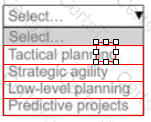
Which agile practice would most significantly increase a team's velocity?
The transition of a monthly news publication from paper to digital is planned to start in the next few weeks. There is a debate between the product owner and the development team about the initial features to be made available and the first five stages of implementation.
What should the scrum master do to address this situation?
A product owner adds user stories to the backlog on a daily basis. The stories are vague requests, and the product owner expects the details to be clarified once the team works on the prioritization list.
How should the team members address this challenge so that the prioritization meeting does not become a brainstorming session?
What should the project team do next?
A scrum master is working with a team on a complex software project that is scheduled to run for 2 years with a series of product releases. The scrum master is responsible for planning the project for the next 6 months and has advised planning the project up front.
What should the scrum master do?
During an executive review, a scrum master uses a burndown chart to demonstrate team deliverables through time. The scrum master declared that velocity increased from 27 to 35 over the last 3 sprints, but one of the executives asks to clarify the importance of these metrics.
How should the scrum master respond?

The team is considering committing to 44 story points for the upcoming sprint. Based on the
velocity chart, what advice should the scrum master offer the team?
What should the team do to effectively manage this?
A new project is under way and the team is using the Kanban method. One of the team members raised a specific issue related to a programming language that the team member faced in previous projects.
What should the project leader do to handle the issue?
An agile team is working on a new product and is behind with their deliverables for the quarterly release. The team discovers new issues during each iteration. They start working on the critical issues and sometimes forget to update the backlog. This leads to confusion, delays, and occasional rework.
How should the agile practitioner improve the team’s productivity?
What should the Scrum Master do first?
What should the product owner do?
Senior management is frustrated at the lack of a detailed implementation plan that shows exactly when the project will end and when all requirements will be met. The team has been using a rolling wave planning approach so far on the project.
How should the agile practitioner explain to senior management the benefits of this approach?
During an iteration, an urgent customer request for support reaches the team. If they work on it, the team's commitments in this iteration are at risk.
What should the team do next?
After a successful product deployment, a key stakeholder informs an agile team member that an implemented feature is failing to deliver its expected business value. The team member replies that the requirement was provided by the customer, and that the scope was clearly met.
If the problem were an issue of requirement elicitation rather than delivery, what should have been done to avoid this situation?
A software company is developing an accounting software system to market to customers. The team has been working on the project for six weeks and has great velocity. One of the major stakeholders approached the Scrum Master and asked for a bi-weekly status report because they feel they are not being properly updated.
How should the Scrum Master respond to this request?
A manufacturing shop is using Kanban to plan, visualize workflow, and limit work in process (WIP). Which productivity key performance indicator (KPI) should the team lead be monitoring on a regular basis?
A product owner wants to create a release plan given the team is working in a chaotic environment. They want to set expectations about what is likely to be developed and in what timeframe for some of the stakeholders.
What should the product owner include in the release plan to achieve this?
A seven-member agile team's composition varies considerably in age, gender, culture, personality type, and professional background. When planning a team-building event, what type of interpersonal skills should the project leader use?
A team lead reviews processes and identifies bottlenecks that prevent the teams from quickly delivering minimum viable products (MVPs). Which responsibility falls within the context of servant leadership?
What should the agile practitioner do?
A project team realizes that an important task on the iteration backlog will take more time than originally estimated.
What should the project team do?
During sprint retrospectives, some team members are very vocal and tend to dominate the conversation, while others are more reserved and less likely to participate. What should the Scrum Master do?
What should the team do?
An agile team is building a training safety video based on current government regulations. The agile coach knows the regulations are likely to change before the release date.
How should the agile coach address this change?
What should the agile coach tell the team?
A client has provided their requirements and deadline to the project team. The requirements are confusing, and the team is frustrated.
What should the team's servant leader do?
A scrum master has a team of six members. The team complains they are losing time because they are attending meetings for which they see no value.
What should the scrum master do?
As part of the organizational change, all project teams within the digital channel’s portfolio have been directed to move from 3-week iterations to 2-week iterations. The development team is frustrated as they think there will not be enough time to test. The product owner does not like this change as it will increase the number of ceremonies.
Which two actions should the scrum master take? (Choose two.)
The product owner is very concerned about work not being completed and tested before a hard release date.
What can the agile team do to mitigate this risk?
An organization wants to execute a corporate website redesign project using Scrum. There is an experienced pool of agile team members from a previous project, as well as a pool of available internal team members with some Scrum background.
What should be considered when selecting the team?
An agile team member from a cross-functional team has been unable to complete assignments due to tasks assigned by the functional manager.
What should the Scrum Master do?
An agile team has defined their definition of done (DoD) for a sprint. However, during the demo, the product owner is not sure if a user story can be marked as done.
Select the most appropriate sequence of activities that would need to be completed to meet a well-defined, mature definition of done (DoD).
A project team is working with an enterprise agile center of excellence (CoE) to transition to a Scaled Agile Framework (SAFe). Many of the team members are not familiar with the new methodology and are worried that it will lead to more work and scrutiny.
What should the agile team lead do to help ensure a smooth transition?
Midway through a project, the product owner learns from the sponsor that a major component, which is already 20 percent complete, is unimportant to users. The component was part of the approved scope and a key selling point for the project.
What should the product owner do next?
The team underestimated the complexity of a story, resulting in new decomposition of the work to be delivered in the current sprint and items to be returned to the backlog. What should the Scrum Master do next?